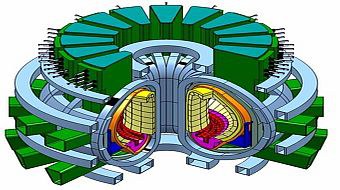DEMO
The European consortium "EUROfusion" is currently working intensively on a concept for a first demonstration fusion reactor (DEMO).
Its performance data should go significantly beyond the "ITER" fusion experiment: DEMO is aiming to feed an electrical output of a few hundred megawatts into the power grid for the first time and to demonstrate high availability as a prerequisite for the subsequent commercial use of fusion in a power plant. In order to meet these goals, DEMO has to achieve a higher plasma pressure and thus a higher power gain Q = P_fus / P_ext than ITER, furthermore longer plasma pulses and a longer life time of all components. With the high availability and the large fusion performance of DEMO, there is a significantly higher consumption of tritium compared to ITER. This heavy hydrogen irotope is unstable and has so far only been produced on earth as a by-product in nuclear fission reactors. The amount of tritium currently available worldwide of some 10 kg of tritium is sufficient for the experimental operation at ITER, but not for DEMO. Therefore, the required amount of tritium at DEMO is to be generated completely on site in a "breeding blanket", which surrounds the hot fusion plasma. The neutrons emitted from the plasma penetrate the blanket and react there with lithium, so that tritium and helium are formed. The resulting tritium gas is then collected and fed into the hot fusion plasma. The second required component of the fusion fuel, deuterium, occurs on earth in practically inexhaustible quantities in seawater.
Like ITER, the European DEMO concept is based on toroidal magnetic confinement based on the “tokamak” principle. The hot plasma is enclosed in a magnetic field which is generated by superconducting coils and a current flowing in the plasma. The great challenge is to control the plasma, which is more than 100 million degrees hot, and the heat and particle flows escaping from the plasma so stably that the walls of the plasma chamber can withstand the interaction with the plasma over long periods.
According to current European studies, a DEMO tokamak reactor could have the following operating parameters:
| Plasma volume | 2500 m3 |
|---|---|
| Magnetic field strength | 5.7 tesla |
| Plasma current | 20 megaampere |
| Fusion power | 2000 MW |
| Elektrical output power | 500 MW |
| Pulse length | 2 hours |
| Start of operation | approx. 2050 |

DEMO design study
The development of DEMO will draw on many of the insights gained in the construction and operation of ITER in terms of physics and technology. Nonetheless, work on developing a concept for DEMO must begin today, parallel to work at ITER, so that research activities specific to DEMO can clarify the open questions that ITER is not expected to answer. For instance, the demands placed on the lifetime of materials and the stability of plasma operation will be considerably higher at DEMO than at ITER. The practical realization of a breeding blanket with full tritium self-sufficiency (tritium breeding rate TBR > 1) is crucial to the feasibility of commercial fusion energy. Finally, the requirements on the reliability of plasma control are by far stronger than on ITER, and they will have to be fulfilled using a set of diagnostics and actuators which are quite limited as compared to ITER.
A new European research roadmap for the development of fusion energy defining the key topics for developing DEMO was published in 2012, declaring the goal of realizing commercial energy generation through fusion by 2050 by means of coordinated research activities. In Germany, a close cooperation was initiated in 2010 between the fusion laboratories in Garching, Greifswald, Karlsruhe, and Jülich in order to jointly discuss the state of the knowledge in fusion research and set the course for further research activities with regard to DEMO. Jülich is participating in the coordinated European and German research activities on fusion in the areas of its core competences: plasma-wall interaction, fusion-related materials research, and plasma diagnostics and control. Within the European fusion research, Jülich provides the project leaders for the topics “Materials research” (G. Pintsuk) and “DEMO Diagnostic and Control” (W. Biel).
In Germany, intensive research continues into an alternative concept for confining a hot fusion plasma. In a device known as a stellarator, the magnetic field confining the plasma is produced entirely by the magnetic field coils. This means that, unlike in a tokamak, no plasma current is required, which in principle facilitates plasma discharges of unlimited duration. Jülich is developing measurement technology and preparing and conducting experiments and modelling for the investigation of plasma-wall interaction at the Wendelstein 7-X stellarator in Greifswald.
Finding solutions to the multifaceted problems associated with DEMO’s development calls for close collaboration between physicists and engineers from various disciplines. Subtasks in this project can also be assigned to students in the form of master’s or PhD theses.
Contact
Prof. Dr. Wolfgang Biel
Tel. +49 2461 61-5151
Fax +49 2461 61-5452
w.biel@fz-juelich.de
